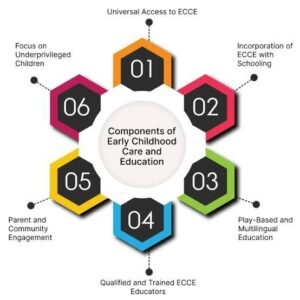Close your eyes and picture this.
Two children. Same age. One walks into a bright, activity-filled preschool. The other waits outside, age three, because her village government school only begins from Class1.That’s not a gap. That’s inequality by design.
For decades, early learning in India has been a private luxury and a public afterthought. The National Education Policy 2020 (NEP) is changing that—brick by brick, class by class.
Finally, preschool is not a privilege. It’s a right.

The First Big Shift: Expansion
The government is rolling out preschool classes—Balvatika 1, 2, 3—inside government schools.
No more waiting till Class 1.
That means a 3-year-old child in a tribal belt now has the same shot at foundational learning as a child in a Delhi nursery.
Until now, ECCE infrastructure stagnated at 14 lakh Anganwadis—grossly under-supported, under-staffed, under-trained. Now, that entire pipeline is expanding into schools.
This isn’t about adding more classrooms. It’s about rewiring the start of the system.
Recruitment. Training. Learning material. Financing. It’s a full-stack shift.
Second Shift: Parents Are Voting With Their Feet
In Dadra and Nagar Haveli and Daman and Diu, all primary schools now run preschool classes. Result? Parents are pulling their 3–6-year-olds out of Anganwadis and into schools.
Why?
Because when given the option, parents choose what they perceive as better opportunities. Schools feel aspirational. Anganwadis feel like leftovers.
This is the great silent migration no one’s talking about.
And here’s the kicker: if Anganwadis lose the 3–6-year group, their traditional model collapses. They’re no longer the early childhood anchor.
Third Shift: The Home Visit Revolution (If We’re Brave Enough to Back It)
This could be the most disruptive idea of all—shifting the Anganwadi worker’s role to focus on 0–3-year-olds at home.
Let that sink in.
Forget the blackboard. Go to the kitchen. Go to the cot. Go to where development actually happens in the first 1,000 days.
That’s the real frontier of learning. But right now, Anganwadi workers are overloaded and pulled in all directions. Home visits are the first to fall off the list.
The Perry Preschool study, the Yale-Pratham collaboration in Odisha—all point in one direction: home visits work. They change brain architecture, not just behaviour.
This isn’t just policy talk. It’s biology.
If we don’t use Anganwadi workers for 0–3, we’re missing the neurodevelopmental window that never opens again.
But Let’s Be Real. This Shift Won’t Happen On Paper.
It needs training. It needs monitoring. It needs local buy-in.
It means retraining Anganwadi workers to be more than feeders—they become first educators.
We also need to guard against the school-ification of preschool. The answer isn’t just more ABCs. It’s age-appropriate, play-based, child-led learning. If we chase syllabus over stimulation, we’ll lose the plot again.
This Isn’t Just Educational Reform. It’s Justice Reform.
What NEP 2020 really does is level the starting line. It says that a child in a low-income neighbourhood shouldn’t have to wait to be five to learn.
It says preschool is not a side note in nutrition schemes. It’s the start of human capital.
It says that the Anganwadi centre is not a leftover—it’s the front door to India’s future.
Jatin Goyal, in his article for The Hindu, cuts through the noise. He doesn’t just explain policy—he explains what’s at stake. Read his original piece in The Hindu, July 30, 2025 edition.
At Praxia Skill, we don’t just believe in ECCE. We build it. We train educators, equip schools, and enable systems to catch a child before they fall through the cracks.
The roots are finally getting water. Now we must guard against weeds—of poor execution, half-hearted reforms, and cosmetic optics.
Because if we lose this moment, we lose a generation.
And this time, we won’t get a do-over.
Based on an article by Jatin Goyal, published in The Hindu, July 30, 2025

